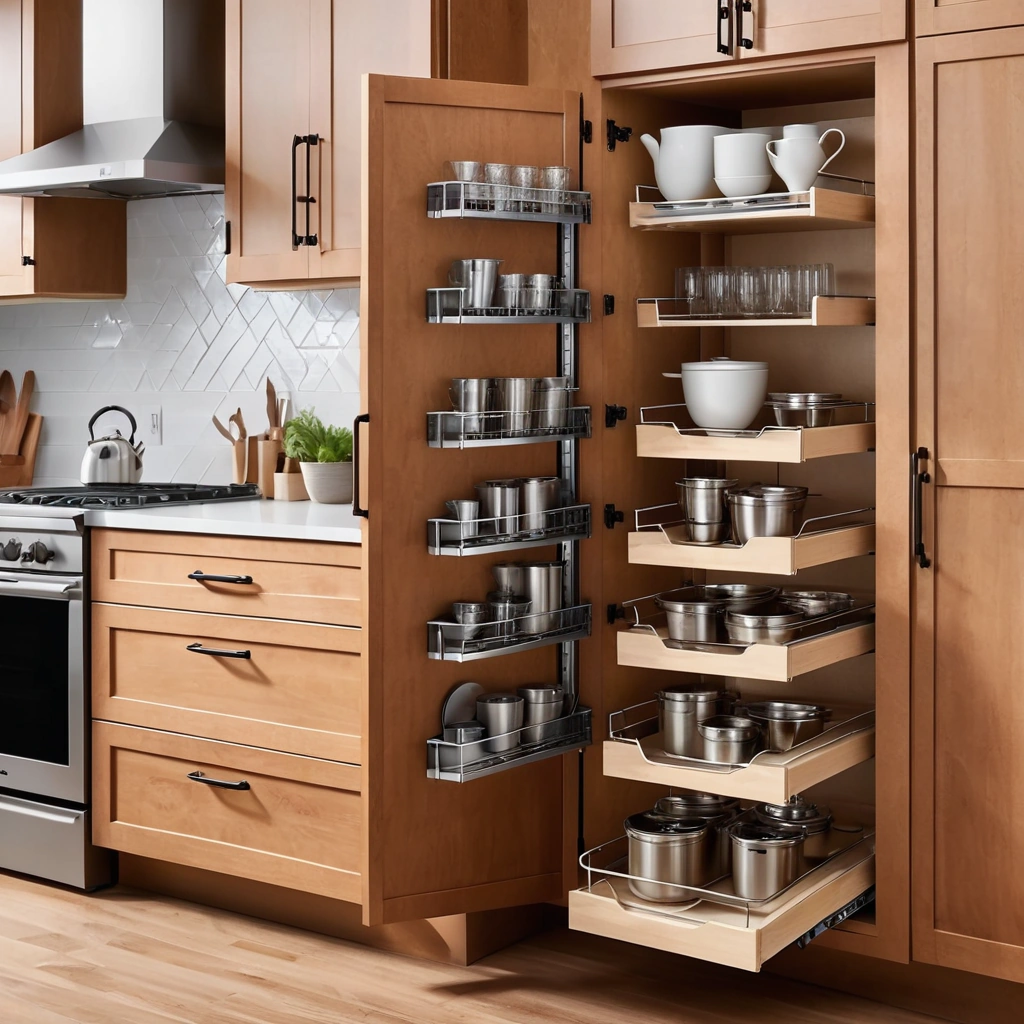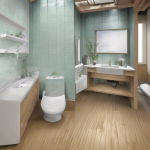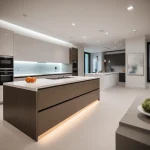Maximize Kitchen Space: Innovative Storage Solutions for Small Kitchens
The Small Kitchen Conundrum: A Quest for Space
The modern kitchen, once a sprawling domain of culinary creation, has often been relegated to a more compact footprint in contemporary homes and apartments. This spatial downsizing presents a unique challenge: how to maximize functionality and storage in a limited area. Forget overflowing countertops and inaccessible cabinets. This comprehensive guide unveils a treasure trove of innovative storage solutions, designed to transform even the tiniest kitchen into an efficient and stylish workspace. Whether you’re a homeowner embarking on a full-scale kitchen remodel or a renter seeking clever ways to optimize your existing space, prepare to discover a world of possibilities that will revolutionize your kitchen experience.
We’ll delve into space-saving solutions like cabinet organizers and pull-out shelves, explore vertical storage marvels, and venture into the exciting realm of smart kitchen technology integrations, all while considering budget, installation complexity, and accessibility. Get ready to unlock the hidden potential of your small kitchen. For many, the quest for small kitchen storage begins with a daunting realization: wasted space is rampant. A recent survey by the National Kitchen and Bath Association revealed that nearly 70% of homeowners feel their current kitchen storage is inadequate.
This inadequacy often stems from poorly designed cabinet interiors and a lack of strategic kitchen organization. Before diving into elaborate renovations, consider the low-hanging fruit: kitchen decluttering. Removing unnecessary items and consolidating duplicates can immediately free up valuable real estate. Think about that pasta maker you used once, or the collection of mismatched mugs taking up prime cabinet space. A ruthless purge can be surprisingly effective. Beyond decluttering, a thoughtful kitchen design strategy is paramount.
Consider the flow of your kitchen and how you use different zones. Are your frequently used items easily accessible? Are your spices buried in the back of a cabinet? Implementing space-saving solutions such as an over-the-sink organizer or a hanging pot rack can free up valuable counter and cabinet space. For those undertaking a kitchen remodel, now is the time to integrate smart cabinet lighting to illuminate dark corners and make it easier to find what you need.
Even seemingly small changes, like installing deeper drawers or adding pull-out shelves to existing cabinets, can dramatically improve kitchen organization and accessibility. The goal is to create a kitchen that is not only functional but also a joy to use. Looking further ahead, smart kitchen technology offers exciting possibilities for optimizing storage. Imagine an automated pantry that tracks your inventory and alerts you when you’re running low on essential items. Or smart cabinet lighting that automatically adjusts based on the time of day. While these technologies are still relatively new, they represent the future of kitchen storage, offering unprecedented levels of convenience and efficiency. Even simpler smart home integrations, like voice-controlled lighting and appliances, can enhance the overall kitchen experience and make it easier to manage your space. As technology continues to evolve, we can expect to see even more innovative solutions emerge, further transforming the way we think about and interact with our kitchens.
Conquering Cabinet Clutter: The Organizer’s Arsenal
The heart of kitchen optimization lies in clever cabinet organization, transforming cramped spaces into efficient culinary centers. Think beyond simply stuffing items into cupboards; strategic arrangement is key to maximizing every inch. Here are three key strategies, enhanced with insights for the modern homeowner: 1. Space-Saving Cabinet Organizers: These are your first line of defense against small kitchen storage chaos. Tiered shelves are invaluable for canned goods and spices, while pull-out drawers bring order to pots, pans, and even small appliances.
Door-mounted racks are perfect for frequently used items like cleaning supplies or measuring cups, freeing up valuable shelf space. Look for adjustable options made from durable materials like stainless steel or reinforced polymer to customize the fit to your specific cabinet dimensions and withstand daily use. According to a recent survey by the National Kitchen and Bath Association (NKBA), homeowners are increasingly prioritizing cabinet organizers in their kitchen remodel plans, with 78% indicating they are ‘very important’ for maximizing space.
Pros: Affordable, often DIY-friendly installation, and significantly increased storage capacity. Cons: Low-quality materials can feel flimsy; accurate measurements are crucial for a proper fit. Consider investing in organizers with non-slip surfaces to prevent items from shifting. 2. Pull-Out Shelves and Drawers: Transform deep, dark cabinets into easily accessible storage zones, a cornerstone of effective kitchen organization. Pull-out shelves bring items to the forefront, eliminating the need to rummage through stacks of cookware or pantry items.
Consider adding soft-close mechanisms for a touch of luxury and to prevent slamming, especially in homes with children. For a kitchen remodel, explore custom-built pull-out solutions that perfectly match your cabinet dimensions and storage needs. These can be tailored to accommodate specific items, such as baking sheets, cutting boards, or even wine bottles. Smart kitchen technology is also making its way into cabinet design, with motorized pull-out shelves that can be controlled via smartphone app.
Pros: Dramatically improves accessibility, maximizes usable space, and prevents items from getting lost. Cons: Can be more expensive than basic organizers; installation may require some DIY skills or professional assistance. 3. Vertical Storage Solutions: Don’t overlook the often-underutilized vertical space in your kitchen; it’s a game-changer for small kitchen storage. Install tall pantry cabinets with adjustable shelves to store everything from dry goods to small appliances. Utilize wall-mounted shelves and racks to display frequently used items, such as cookbooks, utensils, and spice jars.
A hanging pot rack above the island or stove is both functional and aesthetically pleasing, freeing up valuable cabinet space. Over-the-sink organizers provide a convenient spot for drying dishes and storing sponges, maximizing space in a compact area. When planning a kitchen design, consider incorporating vertical storage solutions that complement the overall aesthetic and enhance functionality. Pros: Maximizes storage capacity in small kitchens, keeps items within easy reach, and adds visual interest to the space.
Cons: May require more extensive installation, particularly for tall cabinets; wall-mounted shelves need to be securely anchored to prevent accidents. 4. Smart Cabinet Lighting: Illuminate the depths of your cabinets with integrated lighting solutions. No more fumbling in the dark! LED strip lights, installed along the interior edges of shelves, provide bright, even illumination, making it easier to find what you need. Motion-activated lights turn on automatically when the cabinet door is opened, conserving energy and adding a touch of smart kitchen technology. For a kitchen remodel, consider incorporating smart cabinet lighting into the overall design, choosing fixtures that complement the style and enhance the functionality of your storage spaces. These lighting solutions not only improve visibility but also create a more inviting and visually appealing kitchen environment, contributing to a more enjoyable cooking experience. This is particularly useful in pantries or cabinets where items are stored deep inside.
Beyond Cabinets: Expanding Your Storage Horizons
Beyond cabinets, explore these innovative storage strategies: 1. **Rolling Kitchen Islands and Carts:** These versatile additions provide extra counter space, storage, and mobility. Choose a model with built-in shelves, drawers, and even a drop-leaf extension for added workspace. *Pros:* Offers flexible storage and workspace, can be easily moved around the kitchen, and adds a stylish touch. *Cons:* Can take up valuable floor space; may not be suitable for extremely small kitchens. 2. **Over-the-Sink Organizers:** Maximize the space above your sink with a dish-drying rack, utensil holder, or even a small shelf for cleaning supplies.
These organizers keep your countertops clear and your essentials within easy reach. *Pros:* Utilizes otherwise wasted space, keeps countertops clutter-free, and is relatively inexpensive. *Cons:* Can block natural light; may not be aesthetically pleasing to some. 3. **Hanging Pot Racks:** Free up cabinet space by hanging pots and pans from a ceiling-mounted or wall-mounted rack. This not only provides convenient storage but also adds a touch of rustic charm to your kitchen. *Pros:* Frees up cabinet space, keeps pots and pans within easy reach, and adds a decorative element to the kitchen. *Cons:* Requires secure installation; may not be suitable for low ceilings.
To further optimize your kitchen remodel, consider the often-overlooked potential of vertical storage. Tall, slender pantry cabinets, reaching all the way to the ceiling, can dramatically increase storage capacity without sacrificing valuable floor space. Integrate pull-out shelves within these cabinets for easy access to items stored at the back. According to a recent survey by the National Kitchen and Bath Association (NKBA), homeowners are increasingly prioritizing accessibility in kitchen design, making features like pull-out shelves and vertical dividers highly desirable.
These space-saving solutions are particularly effective in small kitchen storage scenarios, where every inch counts. Don’t underestimate the power of well-placed shelving to transform unused wall space into functional storage zones. Leveraging smart kitchen technology can also revolutionize your kitchen organization. Consider smart cabinet lighting that illuminates dark corners, making it easier to find what you need. Beyond just illumination, some advanced systems now offer inventory management capabilities, tracking what’s stored and when it expires, directly addressing kitchen decluttering challenges.
While automated pantries represent a more significant investment, they embody the future of kitchen storage, minimizing food waste and maximizing efficiency. These innovations are particularly relevant as homeowners increasingly seek to integrate technology seamlessly into their kitchen design, creating a more intuitive and efficient cooking environment. The integration of smart features elevates the functionality of even the most compact kitchen. Finally, don’t forget the importance of multi-functional furniture. A rolling kitchen island, for example, can serve as a prep station, a dining surface, and a storage unit all in one.
Look for models with built-in knife blocks, spice racks, and towel bars to maximize their utility. Similarly, consider investing in stackable containers and nesting bowls to minimize clutter within your cabinets. As designer Sarah Miller notes, “The key to successful small kitchen storage is to think vertically and horizontally, utilizing every available space and investing in solutions that serve multiple purposes.” By embracing these strategies, you can transform even the smallest kitchen into a highly functional and organized space.
The Future of Kitchen Storage: Embracing Smart Technology
Looking ahead to the next decade, smart technology is poised to revolutionize kitchen storage, moving beyond mere convenience to become an integral part of efficient kitchen design and management. This shift impacts everything from kitchen remodels to simple space-saving solutions. As kitchens become increasingly integrated with smart home ecosystems, the possibilities for optimizing storage through technology are expanding rapidly. These advancements not only address the challenges of small kitchen storage but also offer a glimpse into a future where kitchen organization is proactive and intuitive.
For homeowners undertaking a kitchen remodel, incorporating these technologies early in the design phase can maximize their impact and seamlessly integrate them into the overall aesthetic. One of the most compelling innovations is the **Automated Pantry**. Imagine a pantry that automatically rotates items, bringing the oldest products to the front to prevent spoilage, effectively eliminating the dreaded back-of-the-shelf graveyard. These systems, often incorporating sophisticated sensors and robotics, can also track inventory in real-time, alerting you when supplies are running low and even generating shopping lists based on your consumption patterns.
Some high-end models can even integrate with online grocery services for automated ordering. *Pros:* Reduces food waste significantly, ensures optimal organization, simplifies grocery shopping, and provides valuable insights into consumption habits. *Cons:* High initial cost; requires professional installation and programming, and may necessitate structural modifications during a kitchen remodel. **Smart Cabinet Lighting** represents another facet of this technological evolution. Forget fumbling in dimly lit cabinets; integrated lighting systems illuminate the contents of your cabinets the moment you open them, making it infinitely easier to find exactly what you need, especially in a bustling kitchen environment.
These systems often use LED technology for energy efficiency and can be customized with adjustable brightness and color temperature to suit your preferences. Some advanced systems can even be controlled with voice commands or integrated with motion sensors for hands-free operation. This is particularly beneficial for those focusing on aging-in-place home improvements. *Pros:* Dramatically improves visibility, enhances the overall kitchen experience, adds a touch of luxury, and increases safety by preventing accidents in dimly lit spaces. *Cons:* Requires electrical wiring, potentially necessitating professional installation; may be more expensive than traditional cabinet lighting, and requires careful planning during kitchen design.
**App-Controlled Storage Systems** take kitchen organization to the next level by providing unparalleled convenience and control directly from your smartphone. These systems allow you to monitor your pantry inventory in real-time, track expiration dates to minimize waste, and even order groceries directly from your preferred retailers with a few taps. Advanced features may include barcode scanning for easy item entry and integration with recipe apps to suggest meals based on available ingredients. Such systems are increasingly popular in modern kitchen design, especially in urban environments where convenience is paramount. *Pros:* Provides real-time inventory management, simplifies grocery shopping, reduces food waste, and promotes healthier eating habits by keeping track of nutritional information. *Cons:* Requires a reliable internet connection, raises privacy concerns about data collection and usage, and depends on the ongoing availability of app support and updates.
Beyond these core technologies, we’re also seeing the emergence of other smart storage solutions. Consider **integrated weighing scales** in drawers for precise recipe measurements, or **temperature-controlled drawers** for optimal storage of produce and perishable items. Furthermore, advancements in sensor technology are enabling the development of smart shelves that can detect the weight and type of items placed on them, automatically adjusting storage parameters like humidity and ventilation. These innovations are reshaping how we think about kitchen storage, transforming it from a passive space into an active and intelligent system that optimizes food preservation, reduces waste, and enhances the overall cooking experience. The integration of such technologies will become increasingly crucial in future kitchen remodel projects, providing homeowners with more efficient and sustainable kitchen solutions. This will necessitate smart kitchen technology solutions for small kitchen storage.
Declutter and Optimize: The Foundation of Kitchen Bliss
Before investing in new small kitchen storage solutions, a rigorous kitchen decluttering process is paramount. This isn’t merely tidying; it’s a strategic assessment of your culinary inventory. Begin by ruthlessly purging expired items and duplicates. Donate appliances gathering dust in the back of cabinets. Consider a minimalist approach: if an item hasn’t been used in six months, its value is questionable. This initial purge creates a blank canvas, allowing you to accurately gauge your storage needs and avoid purchasing solutions for items you don’t truly require.
Think of it as the essential first step in any successful kitchen remodel, laying the groundwork for efficient kitchen organization. Once decluttered, optimize existing space with strategic kitchen organization techniques. Maximize vertical storage by installing pull-out shelves in deep cabinets, transforming wasted space into easily accessible storage. Implement a first-in, first-out system, rotating stock to minimize food waste. Utilize clear containers – a cornerstone of effective kitchen design – to visually inventory pantry staples and prevent forgotten items from languishing at the back.
Consider installing smart cabinet lighting that illuminates dark corners, making it easier to locate items and further optimize space. These seemingly small adjustments can dramatically increase usable storage capacity without requiring extensive renovations. Looking beyond traditional methods, explore space-saving solutions that integrate seamlessly into your existing kitchen. An over-the-sink organizer provides a convenient spot for dishwashing essentials, freeing up valuable counter space. A rolling kitchen island offers flexible storage and workspace, easily moved to adapt to your culinary needs.
For the ambitious home improvement enthusiast, consider a hanging pot rack, transforming unused ceiling space into a stylish and functional storage solution. As you plan your kitchen remodel, remember that even minor adjustments can yield significant improvements in storage efficiency. The future of kitchen storage lies in smart kitchen technology. Imagine an automated pantry that tracks expiration dates and generates shopping lists, minimizing waste and maximizing convenience. Smart cabinet systems could alert you when supplies are running low, seamlessly integrating with online ordering platforms. While still emerging, these technologies represent the next frontier in kitchen optimization, promising to transform how we store and manage our culinary resources. Embracing these innovations, alongside foundational principles of decluttering and organization, is the key to unlocking the full potential of your small kitchen and creating a space that is both functional and a joy to use.


